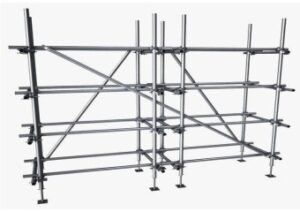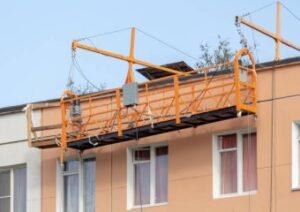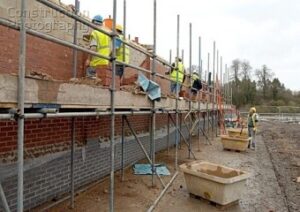Construction is a vast field. It involves so many processes, stages, materials, and tools. Scaffolding is a temporary or movable structure made of wooden planks and metal poles, used by workmen while building, repairing, or cleaning the building, bridges and all other manmade structures. It is also called ‘staging’ or ‘scaffold’. Scaffolds are widely used on construction site to get access to heights and areas that would be otherwise difficult to get to or to reach.
Scaffolding, also called scaffold or staging, is a temporary structure used to support a work crew and materials to aid in the construction, maintenance and repair of buildings, bridges and all other manmade structures. Scaffolding is also used in adapted forms for form work and shoring, grandstand seating, concert stages, access/viewing towers, exhibition stands, ski ramps, half-pipes and art projects. The scaffold has to fulfil a diverse set of requirements: – the creation of safe and productive working areas providing access to working areas at higher levels – carrying area and/or point loads.
Scaffolding work is erecting, altering or dismantling a temporary structure erected to support a platform and from which a person or object could fall more than 4 meters from the platform or the structure. Scaffolding work must be undertaken by a person holding the appropriate class of high-risk work license. This definition applies whenever the term ‘scaffolding work’ is used in this Guide.
Wooden and Bamboo Scaffolding
Although wooden scaffolding is used almost everywhere, there are regulations for how to build it. It is more common outside of North America and Europe. Pre-cut lumber was the most common type of scaffolding until steel, and the fabrication of materials became more affordable. Normally all wooden members, vertical and horizontal are tied with coconut coir rope at all joints. This has a low initial cost but short life. They are not suitable where duration for which scaffolding has to be kept is more or there comes monsoon in between as its strength entirely depends on coconut coir rope.
Tube and Clip Scaffolding
This scaffolding is one of the earliest types of steel scaffolding. It consists of two parts, including the tubes and clips, sometimes called ‘couples’. It is very simple and one also popular because of its easiness in assembly and disassembly. To erect the scaffold, you have to connect tubes together to make long runs and then connect the verticals and horizontals together with clamps built specifically for these tubes. This system is very flexible as you can place the verticals tube wherever you need them. Where other types of scaffolding don’t easily form or adjust to odd shapes, tube and clamp scaffolding can be adapted to round, straight, or irregular shapes. The steel in this type of scaffolding is specially designed to protect against corrosion and rust, which mean that it is a good choice for regions with harsh weather. There are specific requirements that scaffold companies and designers must fulfil. This has a long life but high initial cost.
Cup locks Systems Scaffolding
This type of scaffolding is generally made from galvanized steel. This scaffolding is popular for its capacity to support heavy loads. By using cup locks at every 500 mm to 1,000 mm, this type of scaffolding creates highly standardized systems that work well for scaffolding designs with repeated patterns. This is even costlier, but it is quite strong and safe
There are 8 different types of scaffolding:
Trestle Scaffolding
As the name suggests, this type of Scaffolding is supported on tripod type movable ladders. This type of Scaffolding is used primarily in indoors, like for repairs or painting works. The usage of Trestle Scaffolding is limited to indoors as the height in this Scaffolding is up to 5 meters only.

Steel Scaffolding
Following its name, this Scaffolding is created using steel tubes set by couplers and it is easy to assemble as well as disintegrate. Steel Scaffolding comes with many benefits, thus has a higher strength, durability and is fire resistant. Despite the cost, it is one of the most popular Scaffolding today owing to its benefits. Steel Scaffolding is mainly used for outdoor construction and bigger structures.

Patented Scaffolding
This type of Scaffolding is also made using steel however; these are ready made Scaffolding and are fitted with special couplings and frames etc. The ready made Scaffolding are available in the market and are ready to use once bought. When using the Patented Scaffolding, the working platform is set on the brackets; these brackets can be adjusted to the required level.

Suspended Scaffolding
Suspended Scaffolding is used for a variety of repair works as well as painting. Mainly used in painting as the platform is adjustable to desired length multiple times. Suspended Scaffolding is created using rope or chains tied to the platform for the construction worker, which is then hanged from the roof with the height adjusted at the desired level.

Cantilever Scaffolding
Also known as, Single Frame Scaffolding, Cantilever Scaffolding has limited usage and requires various checks before the installation. In this Scaffolding system, the standards are supported by a chain of needles that are pulled out from the holes in the wall. There is another type of Cantilever Scaffolding, in which instead of all the needles are supported inside the floors through the double frame Scaffolding. One needs to be very careful and follow all the required steps when installing the Cantilever Scaffolding. Given below are the scenarios in which this type of Scaffolding is recommended:

- The top section of the wall is under construction
- The ground is unable to support the standards
- The ground is close to the wall and free from traffic
Single Scaffolding
One of the basic and oldest methods used in Construction, Single scaffolding is mainly used for brick masonry. This type of Scaffolding includes standards, put logs, ledgers, which links to the wall at a distance of 1.2 meters approximately. In addition, Ledgers join the standards at a vertical distance of 1.2 to 1.5 meters while the distance between the standards is 2 to 2.5 meters. Put logs fixed at a distance of 1.2 to 1.5 meters but extracted from a gap in the wall at the end of the ledger. All these technical calculations when followed by book keep the structure sturdy and offer desired support.

Double Scaffolding
Double Scaffolding also knew as the Independent Scaffolding, is the type of Scaffolding that is used mainly for the stone masonry job. It is very difficult to make holes in the stone walls for supporting the put logs, hence two scaffolding together create a sturdy structure for construction work. While the first row is 20 to 30 cm away from the wall, the second one is erected 1 meter far from the first row. With the support of both frames then put logs are positioned. Additional steps are taken to make the structure firmer by adding cross braces and rakers.
Kwik stage Scaffolding
The last but not the least in the list is the Kwik stage Scaffolding system. This Scaffolding is contrived from hard wearing galvanized steel and is admired for its easy installation. Effortless to assemble as well as disintegrate, it is used for both big and small construction works. Kwik stage Scaffolding can easily replace regular scaffold system and provide a safer and strong platform to work. Created using a durable and safe interlocking system, the patented Kwik stage modular system is customization to any desired height.

